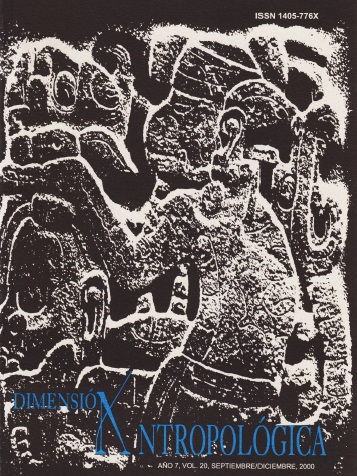Artículos
Publicado 2000-05-01
Palabras clave
- Cultura,
- sistema de parentesco,
- diversidad cultural,
- relativismo cultural,
- mente
Cómo citar
El símbolo como artefacto mediador entre mente y cultura. (2000). Dimensión Antropológica, 20, 7-30. https://revistas.inah.gob.mx/index.php/dimension/article/view/8285
Resumen
Coloquialmente, el empleo de términos como mente o cultura no conlleva dificultad alguna y, de hecho, se suelen usar numerosos sinónimos para ambos conceptos. La mente, por ejemplo, puede equipararse a pensamiento, inteligencia, conciencia o cognición, entre otros, mientras que cultura usualmente puede referir a una sociedad considerada en su totalidad o a estructuras sociales complejas, grupos o colectividades. Sin embargo, cuando ingresamos en el terreno de las definiciones académicas o disciplinares, los problemas se tornan vastos y complejos.
Descargas
Los datos de descarga todavía no están disponibles.
Referencias
- Bajtín, M., El marxismo y la filosofía del lenguaje, Madrid, Alianza, 1992. (Publicado originalmente en 1930 bajo el nombre Voloshinov; con propósitos de unificación, me refiero a este autor con el nombre único de Bajtín).
- Boas, F., The Mind of Primitive Mind, Nueva York, The Free Press, 1965.
- __________, "Limitations of Comparative Anthropogical Method", en P. Bohannan y M. Glazer (eds.) High Points in Anthropology, Nueva York, McGraw-Hill, 1993, p. 75.
- Bruner, J., Actual Minds, Cambridge, Mass., Harvard University Press, 1986.
- __________, Acts of Meaning, Cambridge, Mass., Harvard University Press, 1990.
- Castorina, J. A., E. Ferreiro, Col. de M. Oliveira, y D. Lerner Piaget–Vygotsky. Contribuciones para replantear el debate, Barcelona, Piados, 1996.
- Cole, M., Cultural Psychology. A Once and Future Discipline, Cambridge, Mass., Cambridge University Press, 1996.
- D’Andrade, R., The Development of Cognitive Anthropology, Cambridge, Mass., Cambridge University Press, 1995.
- Durkheim, E., The Rules of Sociological Method, Nueva York, The Free Press, 1982.
- Durkheim, E. y M. Mauss, Primitive classification, Londres, Cohen y West, 1963.
- Gardner, H., The Mind’s New Science. A history of the Cognitive Revolution, Nueva York, Basic Books, 1985.
- Geertz, C., Local Knowledge. Nueva York, Basic Books, 1983.
- __________, La interpretación de las culturas, México, Gedisa, 1991.
- Harré, R. y Gillett, G., The Discursive Mind, Londres, Sage, 1994.
- Hawkins, M., Social Darwinism on European and American Thought, 1860-1943. Nature as Model and Nature as Threat, Nueva York, Cambridge University Press, 1997.
- Hodder, I., Interpretación en arqueología, Barcelona, Crítica, 1988.
- __________, Interpreting Archaeology, Londres, Routledge, 1997.
- Lacasa P., "Internatization and Acquisition of Concepts: Adolescent thinking from the point of view of of Vygotsky and Piaget", en A. Rosa y J. Wertsch (eds.), Explorations in socio-historical studies. Historial and Theoretical discurse, Madrid, Fundación Infancia y Aprendizaje, 1994.
- Lachman, R., Lachman, J. y Butterfield, E. Cognitive Psychology and Information Processing, Nueva Jersey, Lawrence Erlbaum Associates, 1983.
- Leach, E., Cultura y comunicación, México, Siglo XXI, 1993.
- Lévi–Strauss, C., Antropología Estructural, Buenos Aires, Universidad de Buenos Aires, 1969.
- __________, El pensamiento salvaje, México, FCE, 1970.
- __________, The Way of the Masks, Washington, University of Washington Press, 1982.
- __________, La estructuras elementales del parentesco, Barcelona, Origen/Planeta, 1985.
- __________, Myth and Meaning, Nueva York, Schocken Books, 1995.
- __________, Look, Listen, Read, Nueva York, Basic Books, 1997.
- Lévy-Bruhl, L., How Native Thinks, Londres: Allen y Unwin, 1968.
- Martin, L., Nelson, K. y Tobach, E. (eds.) Sociocultural Psychology, Cambridge, Mass., Cambridge University Press, 1995.
- Medina Liberty, A. "La construcción simbólica de la mente humana" en Iztapalapa, 35, UAM-Iztapala, 1994, 9–20.
- __________, La dimensión sociocultural de la enseñanza. La herencia de Vygotsky, México, ILCE, 1997.
- __________, "La naturaleza narrativa de la mente y de la pedagogía", en Educar, 9, 1999, pp. 50–62.
- Morgan, L H., Sociedad antigua, México, CONACULTA, 1993.
- Ochs, E. Indexicality and socialization. En J. Stigler, R. Shweder y G. Herdt (eds.) Cultural Psychology, Cambridge, Mass., Cambridge University Press, 1990.
- Owens, Jr., R., Language Development, Boston, Allyn and Bacon, 1997.
- Peirce, C. S., El hombre, un signo, Barcelona, Crítica, 1988.
- Piaget, J., Biología y conocimiento, México, Siglo XXI, 1969.
- Shanks, M. y Tilley, C., Re-Constructing Archaeology, Cambridge, Mass., Cambridge University Press, 1987.
- Shweder, R. y LeVine, R., (eds.) Culture Theory. Essays on mind, Self and Emotions, Cambridge, Mass., Cambridge University Press, 1984.
- Skinner, B. F., "The phylogeny and ontogeny of behavior", en Science, vol. 153, 5, pp. 1205-1213, 1996.
- Slobin, D. I., The development from child speaker to native speaker. En J. Stigler, R. Shweder y G. Herdt (eds.) Cultural Psychology, Cambridge, Mass., Cambridge University Press, 1990.
- Spencer, H., The Principles of Sociology, Chicago, University of Chicago Press, 1967.
- Turner, V., La selva de los símbolos, México, Siglo XXI, 1980.
- Tylor, E. B., Primitive Culture, Nueva York, Gordon Press, 1967.
- Vygotsky, L., Mind in Society, Cambridge, Mass., Harvard University Press, 1978.
- __________, "Pensamiento y lenguaje", en Obras escogidas, Vol. II. Madrid, Aprendizaje Visor, 1996.
- Wertsch, J. del Río, P. y Álvarez, A., (eds.) Sociocultural Studies of Mind, Cambridge, Mass., Cambridge University Press, 1995.

